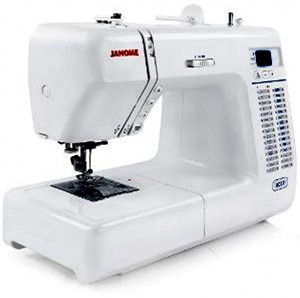 The Janome 8077 features and stitches might look awfully familiar and yet you’ll have a hard time finding anything out about this particular model from Janome. There’s no listing for it on their website and no manual available online. Why? Because it is exactly like the Janome Magnolia 7330 but without the pretty Magnolia graphics.
The Janome 8077 features and stitches might look awfully familiar and yet you’ll have a hard time finding anything out about this particular model from Janome. There’s no listing for it on their website and no manual available online. Why? Because it is exactly like the Janome Magnolia 7330 but without the pretty Magnolia graphics.
My guess is that this model was manufactured originally for another country or maybe it was a private label arrangement with some company at one point because Hancock Fabrics appears to have sold this machine for an extended period of time.
Table of Contents
(Click Ahead!)
Stitch Count / Presser Feet / Functionality / Accessories / Customer Reviews / Pros, Cons & Manual
REVIEW SUMMARY
MODEL: Janome 8077 Sewing Machine
REVIEWED BY: Erin
RATING: 4.6 
LAST UPDATED: April 9, 2015
COMPARE PRICES
Amazon
This is a good sized sewing machine, sturdy and capable of standing up to heavy layers of denim. Stitches are even and of high quality. While it might not have the yellow flowers and purple trim of its twin, it does have a nice, clean control panel that is just as easy to navigate.
It’s also slightly less expensive than the 7330 (read about it here).
Good, Basic Stitch Set
(Back to Top)
This sewing machine comes with 30 built-in stitches including six styles of 1-step buttonholes. Stitch width is adjustable to 7mm and stitch length adjustable to 5mm for certain stitches. Top thread tension is adjustable. There are 15 possible needle position settings.
Following are the names of the built-in stitches along with pictures of the stitches:
You’ll see there are a few quilting and decorative satin stitches along with the most important utility and garment construction stitches plus a great selection of buttonhole styles.
Just Enough Presser Feet
(Back to Top)
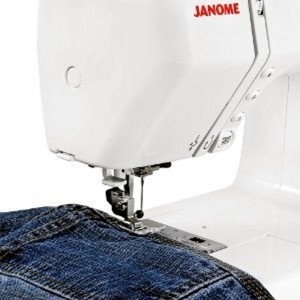 There are four included snap-on presser feet:
There are four included snap-on presser feet:
- General Purpose Foot
- Zipper Foot
- Satin Stitch Foot
- Automatic Buttonhole Foot
The presser foot lever has three height settings including the standard down position, up used for removing or inserting your fabrics, and an extra high up setting for working with thicker layers of fabric.
Presser foot pressure is automatic and not manually adjustable but the machine is designed to handle sheer fabrics as well as heavy-weight fabrics.
The Automation Makes Sewing So Easy
(Back to Top)
The worst part of getting ready to sew is always the process of setting up the machine – winding the bobbin, threading the machine, pulling up the bobbin thread and checking top thread tension. All of that has been made nearly effortless.
Easy Machine Threading
- Automatic bobbin winder stops when the bobbin is full.
- Top drop-in, jam-proof bobbin system takes care of pulling up the bobbin thread for you. For beginners, it doesn’t take long to learn that sewing off of the edge of your fabric can jam up machine thread pretty quickly – not here.
- Easy to follow threading guidelines for top thread.
- Automatic needle threader makes it a snap to get the thread through the eye of the needle.
- Horizontal top thread delivery reduces thread breakage and has been shown to deliver thread more smoothly than the traditional vertical thread delivery set up.
Push Button Controls
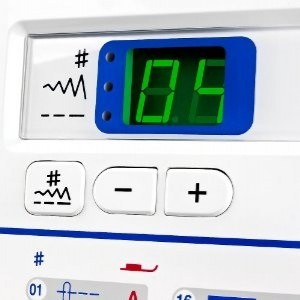 With the touch of a button, you decide which features you want the machine to apply during sewing:
With the touch of a button, you decide which features you want the machine to apply during sewing:
- Start/Stop Button – Sew with the push of a button. No need to use the foot pedal.
- Reverse Button – Conveniently located above the needle arm.
- Needle Up/Down Button – You decide if the needle will stop in the up or down position. This is a huge help in making perfectly tight corners.
- Auto Lock Button – Takes care of tying off your stitches.
- Speed Control Slider – Want to take it slow? A beginner just learning to sew? Teaching a young child how to put together their first quilt? Reduce the maximum sewing speed with a slide of this button and the machine will stay under that limit.
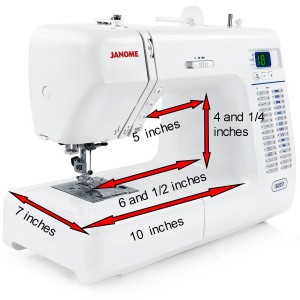 There’s a nice sized throat space to work with and I’ve laid out the dimensions in this photo.
There’s a nice sized throat space to work with and I’ve laid out the dimensions in this photo.
This sewing machine has a superior feed dog system – 7 point contact in a box rotation pattern for extremely consistent fabric movement.
The bobbin cover is see-through so you know how much thread you have left before you launch into your project. There’s a bright LED light over the needle arm and a built-in carry handle so you can easily move the machine around your house.
The drop feed dog system allows for free motion quilting, free motion embroidery, darning, and button attachment. With the push of a button, you can also repeat and reinforce your buttonhole stitches.
The extension arm can be removed for free-arm sewing.
Dimensions: Approximately L 16” x W 11” x D 7”
Machine Weight: 18.2 lbs
Includes These Sewing Accessories
(Back to Top)
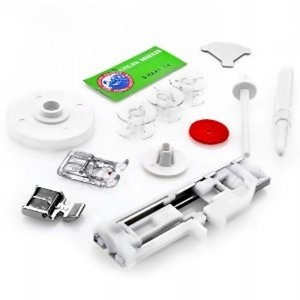 An assortment of tools and sewing accessories store inside an accessory bag that tucks into the machine’s extension arm:
An assortment of tools and sewing accessories store inside an accessory bag that tucks into the machine’s extension arm:
- Screwdriver
- 4 Bobbins
- 3 pack of needles
- Seam Ripper
- Additional Spool Pin
- 2 Spool Holders (small and large)
- Spool Stand
- Felt
Well Loved By Those Who Have One
Considering you get all the bells and whistles that come with the Magnolia 7330 for a cheaper price, what’s not to love? Most users like the reliability you get with the Janome name and this machine truly does excellent stitch work. It sews straight with little guidance, provides consistent power, and is easy to use. It may not have all the stitches found on some of the less expensive brands on the market but it’s a solid machine built to last.
Users rated it as being very quiet, easy to use, and great for all kinds of sewing projects.
A total of 20 reviews have been added to Amazon and users are giving this machine an excellent rating.
Average Rating: 4.6
Pros, Cons & Manual
![]() Pros: Superior feed dog system. Drop feed dog functionality. Easy bobbin system. Automatic needle threader. Start/Stop button. Needle Up/Down button. Speed control slider. Able to sew without the foot pedal. Precision stitching. Sturdy machine size and weight.
Pros: Superior feed dog system. Drop feed dog functionality. Easy bobbin system. Automatic needle threader. Start/Stop button. Needle Up/Down button. Speed control slider. Able to sew without the foot pedal. Precision stitching. Sturdy machine size and weight.
![]() Cons: Presser foot pressure is not adjustable. Not as many decorative stitches as some other machines. No cover or case included with purchase. The machine uses the buttonhole foot and stitches for darning. This is fine unless you have to darn holes in circular fabric like the knees on pant legs. Because you have to rotate the clothing 90 degrees to complete the darning stitch and since the material is round and only slips over the free arm in one direction, you can’t darn those areas. A minor draw back unless you really need a machine to darn holes in pants.
Cons: Presser foot pressure is not adjustable. Not as many decorative stitches as some other machines. No cover or case included with purchase. The machine uses the buttonhole foot and stitches for darning. This is fine unless you have to darn holes in circular fabric like the knees on pant legs. Because you have to rotate the clothing 90 degrees to complete the darning stitch and since the material is round and only slips over the free arm in one direction, you can’t darn those areas. A minor draw back unless you really need a machine to darn holes in pants.
I can’t locate the manual online but you can see the one for the Magnolia here and as they are the same machine this should suffice: Manual
Manufacturer’s Warranty: In the US, as of this date, it comes with a 20 year warranty on parts, 2 years on electrical, 1 year on labor and may be voided by certain activities.
Compare prices at these stores to get the best deal:
COMPARE PRICES
Amazon
Features Summary Review:
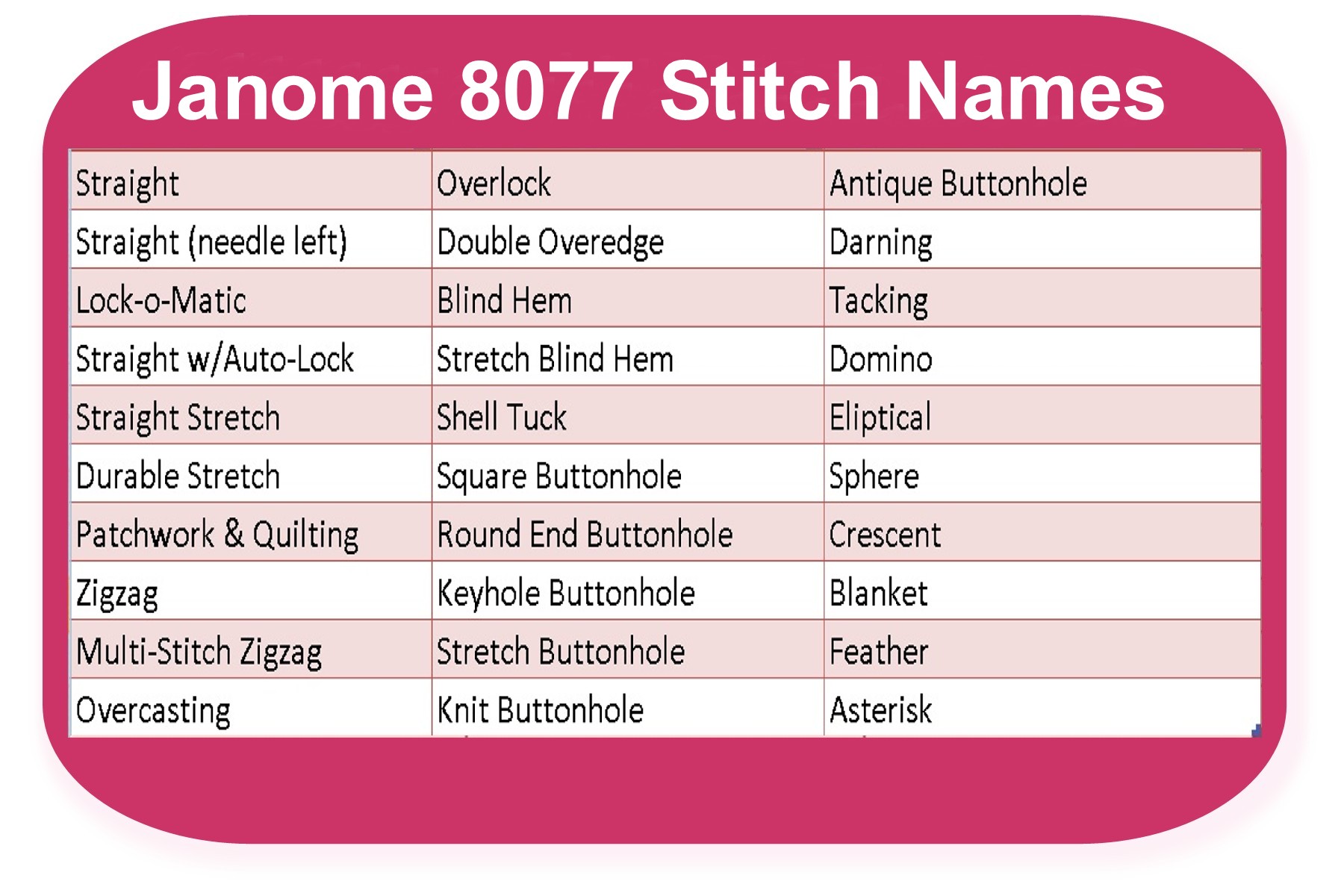
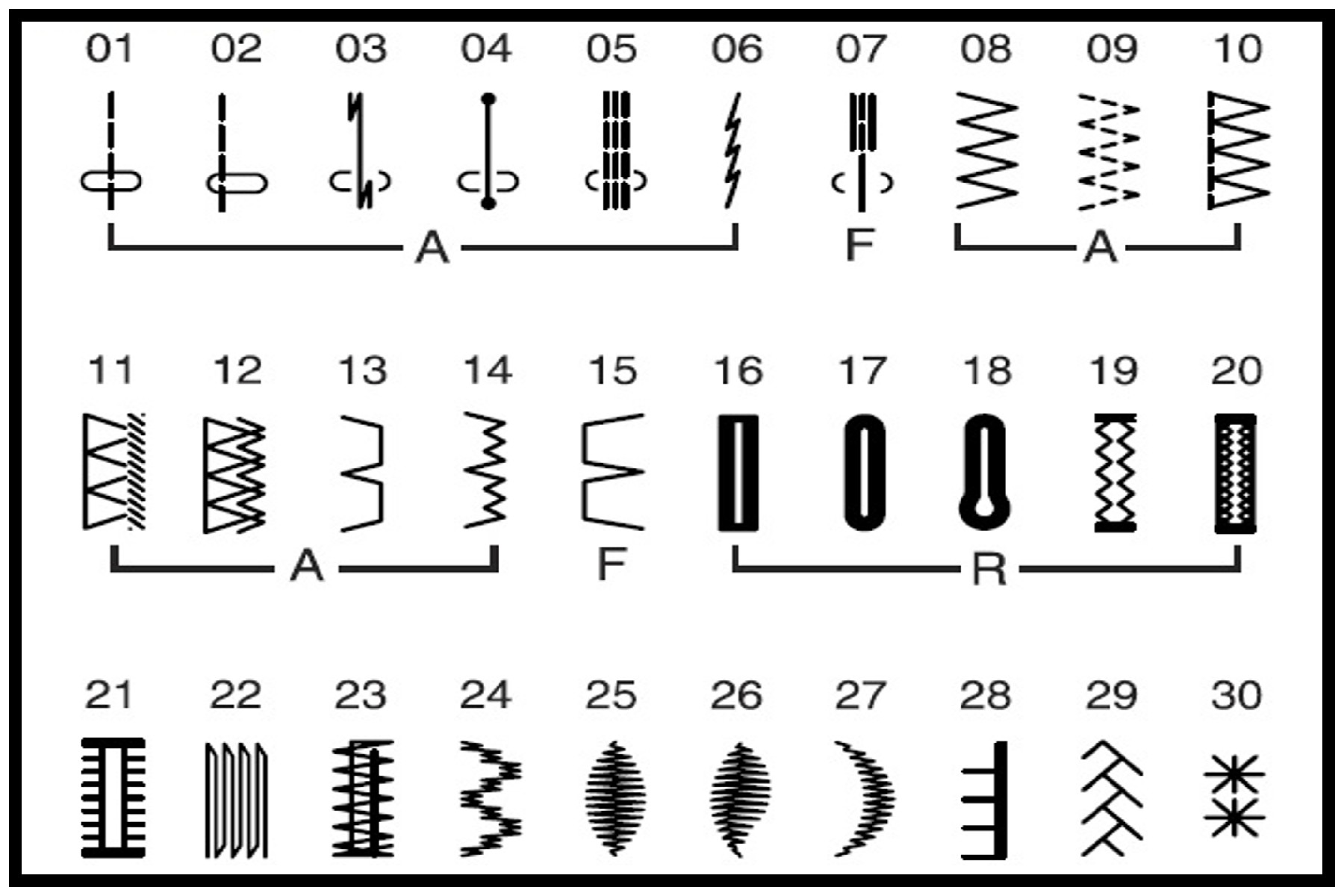
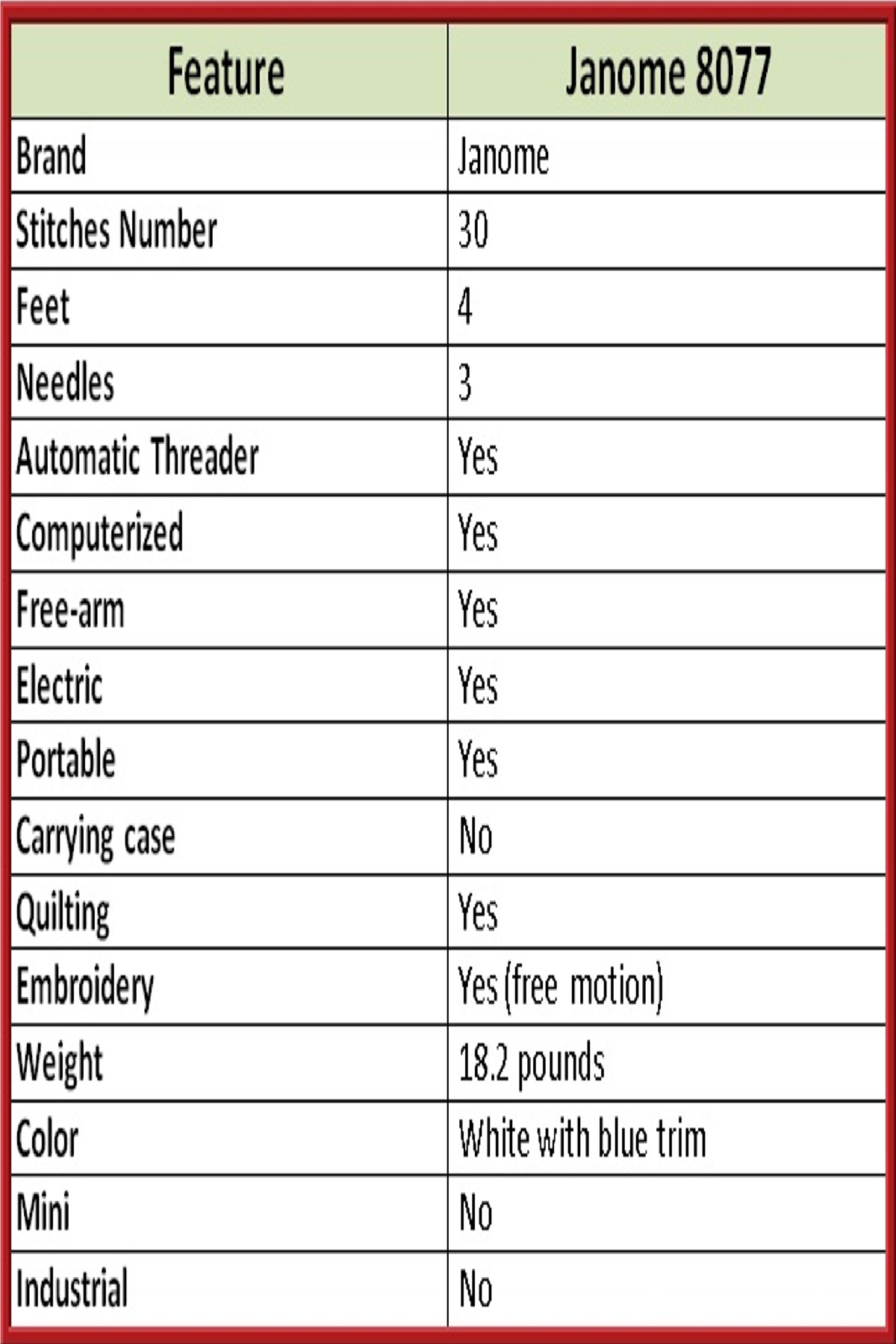
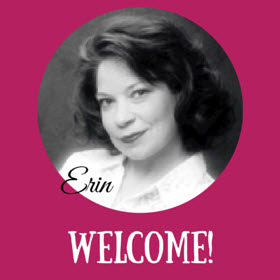
I’m new to sewing but interested to get into it. I’m looking for a computerized sewing machine that I can grow into, that’s reliable and not break down in a couple of years’ time. I also want a machine with features like speed control, needle up-down button, start-stop button, reverse button perhaps. I read many reviews and leaning towards Janome 7330 Magnolia, Janome 8077 and Brother PC-210 (in the $349 to $399) range. Is Brother PC-210 sewing machine of this price range a dependable one? Is it worth spending that extra $50 on PC-210 just so to have more stitches and feet? What would be good choice for a beginner like me? Thanks for any input.
Joanne – All of those machines certainly meet your requirements. They’re easy to use which, I think, makes it more enjoyable for a beginner to learn to sew. All three take care of those more finicky machine set up tasks so that you can get sewing more quickly than on the more manual machines.
These points might help you make your decision:
1. Because these machines use what are called “low-shank” presser feet (meaning there’s a shorter connection arm on the presser foot itself), you can buy additional presser feet at a later date either from the manufacturer or generic presser feet from a company called Distinctive. This means that choosing either the 7330 or 8077 does not mean you’ve given up the future potential of using the same presser feet that come with the PC-210. However, you’d have to pay later to get those additional presser feet.
2. There’s one important distinction between these machines – only the PC-210 has adjustable presser foot pressure. To more experienced sewers, this is an important factor. Adjustable presser foot pressure allows you to fine-tune how much the presser foot pushes down on the fabric to keep it in contact with the feed dogs. This can improve the feed dog performance on different fabric thicknesses. However, the Janome machines do a good job of this themselves and have superior feed dog systems.
3. Of these 3 machines, only the PC-210 comes with a case so the extra $50 is actually covering the expense of physical items (case and additional presser feet) that come with the sewing machine. If you think you’d want those items now or down the road, then you’d be spending roughly the same amount whether you bought one of the Janome’s or the Brother – it’s just that the Brother would be all up front while you could spread that money out for the Janome (machine now, additional presser feet or case later).
If you remove those major differences – case, presser feet and pressure foot pressure – you’re left with the difference in stitches and those really amount to just additional decorative stitches. As a beginners, you’re not likely to use those as much at first and whether those additional stitches will be worth it to you or not will depend a lot on the kind of sewing you intend to do. If you like doing crafts and like to experiment with different styles, you may find those additional stitches are valuable to you. If, however, your focus is on garment construction, they may not be something you use very much.
I hope this helps! Your question is particularly intriguing to me because those are the exact machines I have considered my own personal favorites in the list I’ve collected and I think I’d go with the Brother myself EXCEPT I keep getting drawn in by the look of the darn Magnolia. Those flowers on the face can really mess with the decision making process. 🙂
You’ve obviously done your homework and I think you’re really going to enjoy yourself the more you get into sewing. 🙂
Sincerely,
Erin
Erin-Thanks for your help and explaining the differences in them. Your site is great…your comprehensive reviews really help a lot!
Sincerely,
Joanne
Aw! You made my day! 🙂 Good luck shopping and I’m sure you’re going to make some marvelous projects! Thank you, Erin
Hello. Thank you for your machine reviews! I am looking to confirm that the Janome 8077 also has the automatic thread tension feature that the Magnolia 7330 has. Do you know if it does? All the reviews of the 8077 I’ve read state that the top thread is adjustable but none have mentioned automation. Thank you again!
Suzy – I happen to have the Magnolia 7330 and “automatic” probably means different things to different people. 😉 They each actually have manual thread tension control. Both come set at a default tension setting that works with most fabrics and stitches so it’s not like you have to adjust it constantly unless the bulk of your work is with specialty fabrics. I haven’t had to change mine yet but most of my work is done with medium weight cottons. Is there a specific project purpose that has you more interested in a machine with automated tension? I could poke around and see what matches come up, if it would help.
Sincerely,
Erin
Erin – Thank you for your quick response. I’m a beginner sewer and when I read that the Magnolia 7330 had automatic tension I thought that sounded like an incredible feature. I suppose I misunderstood what “automatic” meant but thank you very much for clarifying it for me! I’m going to put the Janome 8077 on the top of my Christmas wish-list. 😀 I greatly appreciate your reviews and your help. Thank you!
Suzy – When I was out shopping for machines earlier this year, I couldn’t resist looking at the top of the line Husqvarna. It cost something like $8000. It was beautiful and when the saleswoman told me the price I told her that for that kind of money I should be able to push a button and have it spit out a completed pair of jeans. I wish you could have seen the look on her face! It was apparent that some experienced sewers don’t want to automate themselves right out of the picture. 🙂 Me, on the other hand – I want to enjoy the experience but the creative side. I don’t want to have to mess with a bunch of settings. The automation in the 8077 and the 7330 is ideal and the tension shouldn’t give you any trouble. The manual is very helpful for making any adjustment for specialty fabrics and you can go right back to the regular setting as soon as you’re done. Everything else is completely push-button operated. I haven’t even hooked up the foot pedal. Ever. Makes it easy to move around the house, too, and sew anywhere I want. I actually chuckle every time I come across the foot pedal tucked away in my sewing drawer.
Enjoy and happy holidays! Hope Santa brings you the 8077!
Erin 😉
Hi,
I am planning to buy the Janome 8077, and am wondering if it comes with foot pedal.
I know it has start/stop button, and I love the feature for basic use.
However, I would like to use the foot pedal when I sew little more complicated stuff.
Please let me know!
Thanks,
Rica
I just placed my order for the Janome 8077 and can hardly wait to get it! Erin thank you so very much for your extensive website that allowed me to chose my new machine (although it was still very hard because of all the choices!) I am new to sewing and have been apprehensive because of my experience with my mom’s OLD Singer that I could never get to work for ME. I am so excited to get started on some projects. YAY!
I had a summer dress that I wanted to make for myself, and the 1975 Singer that I have just wasn’t cutting the mustard with the fun elastic thread (SO COOL!)I went to a friends house and used her CRAZY FANCY Janome Memory Craft and fell in love with all the techi stuff it has. WOW! I won’t be doing that much crafting, but now I won’t feel intimidated by a sewing machine! Thanks again for all your time in putting this site together.
freebyrd – You’re going to love your new machine! It will erase all those bad memories from using the 1975 Singer and I know from experience having last used a 1973 Kenmore and them going to a beautiful Janome myself. NIGHT and DAY would be an understatement!!
Glad the site helped and I’m sure you’re going to have a wonderful summer dress in no time!
Sincerely,
Erin
Erin, your site is so incredibly helpful. I have been researching machines for awhile now and was so glad to read your reviews. Today I thought I had decided on the Janome 7330 Magnolia (due to your review). I want to sew decorator pillows and costumes for my daughter. I am a beginner sewer and have used my Mom’s inexpensive Singer machine with some frustration. I want to be able to grow with my machine and want it to be able to handle heavy materials like leather, faux leather, jeans, etc. I also want to be able to sew through multiple layers of these fabrics. Somehow I missed the Janome 8077 machine. Is it seriously the same as the Magnolia minus the flower graphics? If that’s the case I think I may be sold (have found one online for $279 – wow!). Would you mind letting me know if you think I am on the right track here? Since I am a beginner, I would find it reassuring! Many thanks, Janet
Janet – You’ve got it right, they’re TWINS. When you’re sewing, you won’t even realize the flowers aren’t there. You’ll just love how it performs. It’s a nice solid machine. Not too light, not too heavy. Has great automation and it’s very easy to thread and set up. If you like the stitches that are built in and this is the machine for you, take that savings and run with it! $279 is a great deal!
Sincerely,
Erin
Thanks for the reply Erin :). I am wavering a bit wondering if I want more stitches? I love all the cool stitches Brother machines offer, but I think I am convinced that the Janome is a better overall product… hmmm… There are other Janomes with 50 stitches but not sure they stack up to the quality of the Magnolia/8077 when I read their reviews (decor dc2010 and the dc3050). I am thinking since I am a beginner maybe I should stick to the more straightforward, well reputed machine… like you said, what would I do with those stitches really? It is a hard decision!
I have a Jamone 8077 machine.I was sewing on denim and my thread got hung up.Iuntangled it and the when I tried to sew again the needle will not pick up the bobbin thread.I’m so confused on what to do it looks like it would be so simple but I can’t get it to work. I love this machine it is the best I have ever had. Please help me!!!
Does the Janome 8077 have dual needle capabilities? I don’t use it often but when I need it I really need it.
Susanna, I have the same request, does the Janome 8077 have twin needle capabilities. Did you ever get a response? I haven’t found a way to use them yet?
Pauline – I knew I missed a few questions along the way, sorry!
Yes, the Janome 8077 does have twin needle capabilities. Actually, any machine that has a zigzag stitch can do twin needle sewing because then it means that the opening in the presser foot can accommodate the width of a twin needle. Just make sure to get a twin needle that is not wider than the opening for your maximum zigzag stitch width.
To thread the machine, you’ll need to use the main thread spool and then the auxiliary pin for the second thread. Bring the threads down through the same threading path but then one hooks into one needle and the other goes to the other needle and pay attention to any guiding hooks that are on the twin needle itself to get the thread channeled through the right needle.
If you see the thread bunching at all, you might need to adjust the tension or use some tear away stabilizer if you’re dealing with thin material.
Sincerely,
Erin
Hello Erin,
I have been using the Janome 8077 for over a year now. I have been sewing for years on a “just basic” Singer. After staying a beginner for many years, I decided I wanted to move to advanced and beyond, so I purchased the Janome 8077 from Hancocks. I LOVE it. I am ready to move forward with other feet for my machine, but I am having trouble finding which different accessories will fit with the 8077. And, yes, I could not find 8077 mentioned in the Janome website. Frustration! Can you point me to or suggest what accessories I can use with my new Janome? Thanks.
Erin~
I just came across your website and am blown away by how much information you have here! It’s been so helpful.
I’m in the market for a new sewing machine and think I have it narrowed down to three machines – Janome 8077, Brother CP7500 and Singer 7258.
I mainly sew clothing (adult, children and doll!) and do alterations, although I also do some crafts and quilting. I currently have an old Singer Featherweight and I absolutely love how it sews – the problem is that it only does straight seams and I’m ready for an upgrade!
What are you thoughts on these machines? Is any one of those brands better than the others? It looks like they all have fairly similar features with the exception of how many types of stitches (the Janome has significantly less than either of the others) I would like some decorative stitches, but I currently have one stitch so anything more than that is an upgrade!
I think my most important criteria is longevity – I’d like a machine that will sew well for a long time (my current machine is 80 years old and still going strong!)
Thanks ~ Sidney
I just purchased the Janome 8077 and love it so far. I am a beginner. My question is…what is the best hard cover for the machine? I bought one at walmart but it isn’t tall enough because the spool hits….or am I suppose to take off the spool? The one that Janome sells for around 50.00 doesn’t have a bottom or so it seems. Thanks in advance.
Can you tell me the size of the work area on the Janome 8077? I can’t find it anywhere. Hoping it’s slightly bigger than my 89.00 Brother…
Thanks so much!
Chris
Or maybe it’s called the throat space?? This is all fairly new to me..
Christine – Yes, throat space. Although I usually call it “that big open area between the controls and the needle”. I’m so very much the professional. 😉
I just measured my Janome 7330 Magnolia as they’re the same machine. From the inside of the control side of the machine to the needle itself is 6 and 1/2 inches. From the inside of the control side of the machine to the very outer edge on the left side is 10 inches. From the back of the machine to the front in that work area is just shy of 7 inches. From the ceiling to the floor of that area is 4 and 1/4 inches. From the top of the inside of the control side of the machine to the inside edge of the needle arm is 5 inches.
Hope that’s what you needed!
Sincerely,
Erin
PS – I just added a photo to this post showing the dimensions so you can see where I measured and the related results.
Thank you so much for the information I have this machine and I am tring to teach my self to machine quilt do you know what settings to put it on
Thank You very much and Have a Blessed Day
Belinda Knight
Hi Erin, I hope you are still looking at this thread. I am considering a Janome 8077 or a DC1018. It is hard to find info on the 1018, but it seems like a sturdy machine with just less stitches. I am a “beginner” but have sewed with my Mom’s singer throughout my teen years. I want to alter and make clothing. I like light and stretch fabrics. I want a machine that will be a good investment by not over $300. Any guidance. Oh and I don’t care about electronic, only practical stitches, but a machine that is easy to use on different fabrics. thank you — C
Christina – I’m still here! 😉
The Janome DC1018 is identical in style and features to the Janome DC1050 with the exception of the included stitches. The frame, style, controls, and specifications are the same so it has a 7 piece feed dog, a 7mm max stitch width, and a 5mm max stitch length. The DC1050 has high ratings from consumers and I would assume the DC1018 performs similarly. It’s easy to use and should handle the fabrics you mentioned just fine.
The main differences between the 8077 and the 1018 are the number of stitches and the size of the machine. The DC1018 is slightly smaller and weighs less than the 8077. The automation features are the same with reverse, speed control, and start/stop buttons.
With the DC1018 you’d have all the basic utility stitches you’d need for most projects. The difference in stitches between the two is the extra decorative stitches.
Performance and ease of use are going to be very similar between the two so in order to pick one or the other decide if you need the larger machine or not (the larger size comes in handy if you’re working on large projects like quilts, bedding, curtains, large costumes, furniture covers, etc), if you need the extra decorative stitches, and compare the prices of the two. That should help you finalize your decision and then you can get sewing! 🙂
Sincerely,
Erin
thank you, very helpful. The 1018 is cheaper so I am leaning that way. have a great weekend. — CZ
I am getting a message on my display of “Fv”, but my foot control is plugged in to the machine and all of a sudden it’s sewing by itself! I turned it off, in plugged everything and plugged it back in…any suggestions bc it’s still doing the same thing.
Erin, if by chance you are still updating the comments on this I’d love to have your opinion on which machine you would recommend for me. I think I’ve finally narrowed it down to the 8077 and the DC1050. I mostly quilt, and I’ve gone through 2 inexpensive ($150-ish range) Singers in the last 10 years. They’ve served me well, but I think it is time to look for something a little more reliable and heavy duty. I think part of the reason my most recent one gave out after only 3 years is the fact that I’ve made 4 denim quilts on it. I thought it handled denim fine until I borrowed a friend’s machine to hem a pair of pants and was surprised at how much easier her old Kenmore went through the multiple layers of denim as I went over the seams!
So, to try to wrap this up, which machine would you recommend for someone who sews denim quilts, regular cotton quilts, does a little hemming/clothing construction, and some crafts? (My price range is up around $400 at the moment if there is something else you’d recommend.)
Thanks for the great site and great reviews! You helped me narrow my search from considering almost ALL the brands and being completely overwhelmed to landing on Janome and finally down to these 2!
Kim, I”m still here! Behind on comments (sorry everyone) but have finally been able to clear my calendar a bit so I can focus on the site again.
Between those two, I’d suggest the 8077. While it’s lacking the DC motor it will go through denim as long as you’re talking about going over only one jean’s style seam. I just ran my Magnolia 7330 across the bottom leg of a pair of old jeans as a test for you (so 2 layers of denim and one thick seam) and it plowed through it like a knife through warm butter. I then doubled the leg (so 4 layers of denim and 2 seams – one on top of the other) and only then did it bog down but mostly because that thickness wouldn’t go under the presser foot and I’m not using a heavier needle.
The larger size and weight of the 8077 as compared to the DC1050 will give you a better working space for large projects and more stability, too. It has fewer stitches but they’re plenty for the type of projects you describe. It’s a very solid sewing machine with good structure that should last you quite some time. 😉
Sincerely,
Erin
Thank you! Your website has been a great resource. I realize that it is probably not your full-time job, and I know everyone who has visited appreciates the work you put in.
That said, if you ever got the urge to expand I’m sure a message board with topics on each machine so those of us looking could ask questions to those who have the machines we are looking at – that would be great too!
Thanks again!
Kim, an excellent idea and one I would love to carry out! I’ll have to make it my 2015 New Year’s resolution. 😉 Thanks so much for the compliment!
And… I’m back. I went to my local (1 hr away) Janome dealer on Wednesday to try out the 7330 as they didn’t have the 8077. I was impressed by the way it went through multiple layers of denim but decided not to make the purchase there because I was wondering what kind of deals might come today through Monday. Not to mention the woman in the shop was not very nice. Helpful, but not very nice if that makes any sense. 🙂 Anyway, I came back to your site to see if there were others I had missed in my search and stumbled on your review for the Quantum stylist. I almost wish I hadn’t because now I’m doubting my choice on the Janome! I was planning to stay far, far away from Singers since I’ve had troubles with my last two, but maybe that’s because they were on the “cheaper” end of the Singer spectrum? I have read in other reviews that Singer isn’t maybe as bad as they have been in the past, but given the choice would you trade your 7330 for the Singer Quantum Stylist?
Kim, for me personally, yes – I would prefer the Quantum Stylist over the 7330. I love my 7330 and it’s very sturdy and reliable but I was tired of the stitch selection within a few weeks. I prefer to try lots of different projects and don’t focus on just one kind of sewing or just quilting, for example, so I want to monogram and dress up plain towels I might buy at Walmart to switch up the look in my house. I can’t do as much of that with the 7330.
I think that’s what it comes down to – what’s your “hobby” style? If you like to explore then the Stylist is going to offer a lot more opportunities to jazz things up. The 7330 is what you want when having lots of stitches isn’t as much a need as is a workhorse that’s going to plow through quilts or lots of thick fabrics.
As for the Singer brand they’ve had some ups and down but they have some stellar models in the mix these days and I consider this one of them. 😉
Hi, I recently received the Brother 6000i but I’ve decided to return it- the extras and stitches it comes with are fun but I’ve found the threading and tension to be finicky and it has troubles going straight through multiple levels of fabric, even just quilting fabric. My previous machine was my great grandmother’s 40 year old Viking, which I used for heavier home decor weight fabric, clothing, and piecing quilt tops. I was hoping to find a machine that I could also use for quilting and that would have a more consistant stitch than the Brother, so I was looking at this Janome. Do you have any suggestions for another machine to look at to fit my needs? I did like the fun stitches and easily viewable drop in bobbin that the Brother had, but I was also worry that it wouldn’t last in the long haul. Thank you!
Hi, I recently received a Brother 6000i but am going to return it- although I love all the stitches, I’ve found the threading and tension to be finicky and I think the stitching is not consistent over multiple layers of fabric (even just quilting fabric). My previous machine was my great grandmother’s fifty year old Husquavarna, and I’m looking for a machine for fixing my kids’ jeans, quilting, and home dec projects like slipcovers, etc. I’m considering this Janome 8077, and I was wondering if you had any other suggestions for machines. I did love all the fun stitches on the Brother, but I was concerned about its longevity. Thanks very much- this site has been a great help-